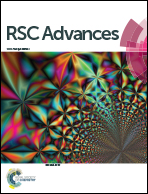Removal of phosphate and chromium(vi) from liquids by an amine-crosslinked nano-Fe3O4 biosorbent derived from corn straw†
Abstract
A magnetic biocomposite based bio-sorbent (corn straw) was prepared after in situ co-precipitation with Fe2+ and Fe3+ solutions and amine functionalization. The characteristics of amine cross-linked magnetic corn straw (ACMCS), spent samples after phosphate and Cr(VI) adsorption, and regeneration samples were evaluated by VSM, TEM, SEM, FTIR, XRD and XPS. Adsorption tests of phosphate and Cr(VI) were also conducted. The TEM images in accord with the VSM results showed that a high number of Fe3O4 particles had been introduced onto the skeleton of corn straw. The XPS results indicated the existence of interactions between amine groups and phosphate/Cr(VI) and low losses of Fe and N in the regenerated adsorbent. Kinetic models showed the rate-limiting step to be chemisorption involving valence forces through sharing or exchange of electrons between adsorbate and adsorbent. After three adsorption–desorption cycles (HCl and NaOH as eluents), there was only a slight loss in adsorption capacity of Cr(VI) and phosphate; this demonstrated that the magnetic biocomposite was renewable in a continuous adsorption process.


 Please wait while we load your content...
Please wait while we load your content...